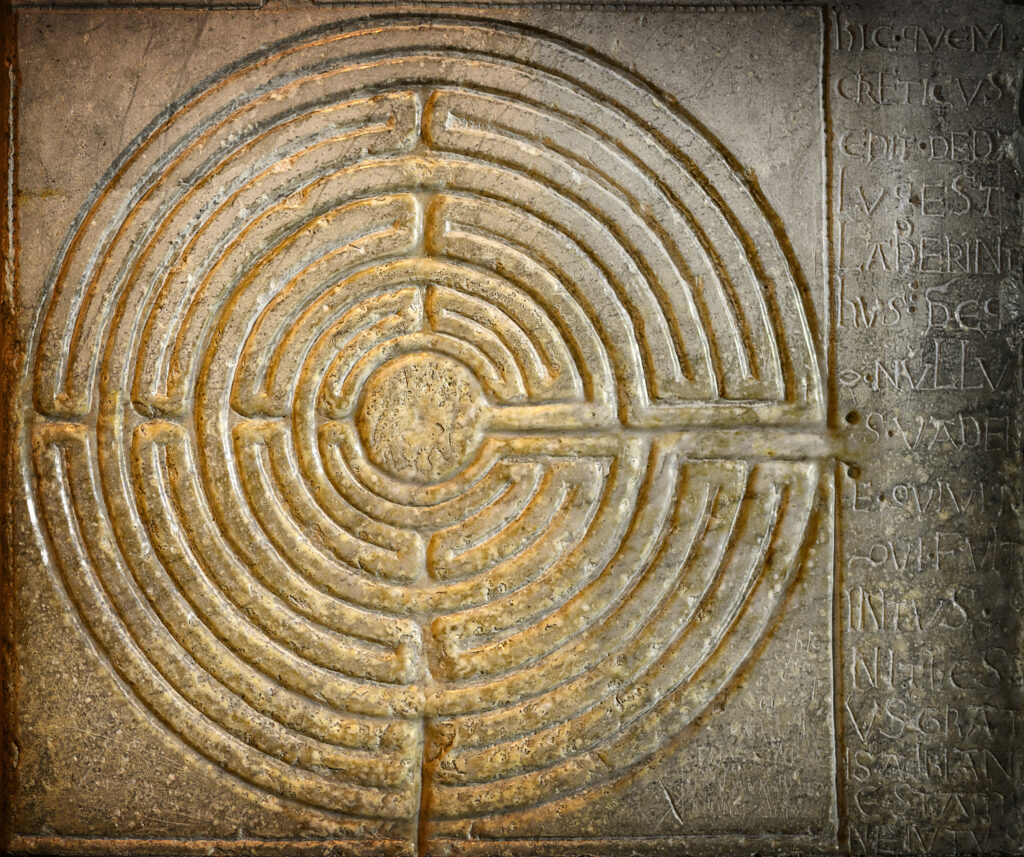An Introduction
Neal Harris, MA, LCPC, DAPA shares his experience in working with labyrinths in his counseling practice.
Looking back on over a decade of using labyrinths in counseling, all indications point to the powerful role they can play in facilitating the therapy process.
I use a finger labyrinth in counseling at the same time as my clients do in order to promote relaxation and the resulting increase in awareness on both our parts. The finger labyrinth helps me be a better listener and helps take a newer client’s attention away from the typical reluctance around talking about their issues. Moving a finger through an inlaid wood path (with eyes open or closed) allows both of us to relax and focus. When this happens, clients become much more aware of their own issues and the blind spots that tend to keep troubling patterns locked in both mind and body. The therapist, in turn becomes more capable of being “tuned in” intuitively to the client’s process and able to facilitate change more readily.
The use of finger labyrinths also helps break down the “professional barrier” that we as therapists are taught (in graduate schools throughout the country) to put solidly in place and keep sacred. By keeping that barrier in place, clients are kept from feeling on an equal footing with their therapists and therapists therefore can maintain the mental illusion that they don’t have any of the problems their clients are having difficulty with. This separation or hierarchy between client and therapist, in my experience, puts the therapist on a pedestal in the client’s eyes, which down the road has great potential for dependence on the therapist, which can lead at best to long-term therapy and at worst to an abuse of power (consciously or unconsciously) on the therapist’s part.
In my practice, I opt to create a healthy footing between myself and my clients by letting my clients know up front that he or she has strengths and weaknesses and I do as well. I model this when I work with a finger labyrinth right alongside them. In this more equal environment, the barriers to effective communication tend to break down, which leads to mutual trust. It has been my experience that rather than hope that trust builds over time (sometimes months or years) finger labyrinth usage tends to speed up this process significantly as the barrier to trust and effective communication (through establishing this hierarchy) is not raised and fortified in the first place.
With the emergence of managed care insurance guidelines in the counseling field, clients are allotted a certain number of sessions to “get better” (usually somewhere between 8-12) and those counseling sessions are paid for by insurance. If clients need more than 8-12 sessions, they must pay for their own therapy or have the therapist petition the insurance company for more sessions. This, in my opinion, makes the use of finger labyrinths that much more valuable, especially to those counselors who are directly tied to managed care for their financial survival. In my experience, finger labyrinths in conjunction with conventional talking therapies tend to foster issue resolution in a speedier timeframe.
I believe (on a more mysterious level) it is also incredibly important to acknowledge the unseen forces that are present in the therapy room (to assist with the unfolding of issues and the therapeutic process). The use of finger labyrinths helps both client and therapist tune into these forces (via the relaxation the pathways afford) to receive the “aha” answers to problems both are carrying with them into the therapeutic relationship.
Case Study 1
The following is an example of using a 2-person, mirror-image, wood finger labyrinth design in therapy. Clara, a very shy, forty year old, woman from Scotland, came to the first session saying in a very meek-sounding voice, “I don’t know what I expect from this, I have nothing to say.”
I proceeded to ask her basic questions about her life and family and found that I was getting one or two-word answers. I decided to try using an Intuipath® with her (a mirror-image, 2-person, 2-handed, double wooden finger labyrinth design).
I took a few moments to explain that it was a relaxation device that might help her to communicate with me. She agreed, and we both took a few deep breaths and began to fingerwalk our own labyrinth design (connected by the same piece of wood), each at our own pace. Clara began to talk about how her schoolteacher colleagues were very social with each other, and how she felt like an outsider with them. She found it hard to make friends. She smiled after several, descriptive, paragraph-like responses ushered forth from her lips, and she added, “I guess I do have something to say.”
After a few sessions, we addressed her low self-esteem and the way her alcoholic father contributed to its formation by discounting everything she said as a child, even in public. This subjugation to her father’s will (and to a degree, her mother’s as well) continued into adulthood on her yearly visits to Scotland. Using the double labyrinth (around the fourth session), she spontaneously verbalized the negative affirmation “I am a weak and uninteresting person.” We fingerwalked a bit more after that, and I asked her to “allow” a positive affirmation to make itself present to her conscious mind. What presented itself was “I am competent in all social situations.” I asked her to say this out loud and see how it sounded. She said it quietly, with a slight crack in her voice. I suspected (because of the difficulty she had in saying this statement with decisiveness and gusto) that we had hit upon some early, negative self-statement that was replaying itself in all of her social interactions, causing her to feel weak, uninteresting, and therefore socially inept. I asked her to take several deep breaths and after each, say the positive version again loudly like she meant it. She did so, and her voice became stronger after each utterance of it. Between sessions, as she was instructed to do, she used this positive affirmation throughout each day, and when she returned to session (after a several-week hiatus which allowed her to return to Scotland for her yearly visit), she reported great changes had taken place in her courage and competence in social situations. She even reported that her relationship with her father shifted to a more satisfying and equal emotional footing. In total, I saw Clara for 12 sessions, and her improvement in self-esteem was maintained as reported by her in a six-month, one-year and two-year follow up.
Utilizing the power and grace of her own intuition and wisdom (elicited in large part through the use of the Intuipath® design), Clara was able to marshal new strength and understanding, and as a result, rapidly change her adaptive responses to gain greater satisfaction and meaning. With her newfound self-esteem and confidence, she was able to gain a sense of clarity and mastery over other issues as well.
Issues to consider when using labyrinths in counseling
While finger labyrinths are a terrific catalyst to most therapeutic issues, some clients will refuse to try them. For instance, those who’ve been brought up in a religion or belief system that associates the labyrinth pattern (or relaxation techniques in general), with fear and misunderstanding. Other potentially difficult situations for using finger labyrinths are with those who are actively psychotic, clinically depressed, in the manic phase of Bipolar Disorder, and those who have Borderline Personality Disorder. This doesn’t mean that you can’t use a finger labyrinth with any of these diagnostically-labeled clients. It just means that more caution should be used as each (with the use of a finger labyrinth) may come face to face with the underlying issues they’ve been trying to consciously avoid dealing with.
In addition, working with finger labyrinths as part of a therapeutic strategy can also present a potential challenge to both newer and more experienced therapists. As I see it, labyrinths are an intuitive playground for the spirit. They involve intuition and a willingness to allow whatever comes up in the process of fingerwalking to surface without judgment or censorship. Therefore, therapists who think they “know” what each of their clients need and have a theoretical road map of how to get each there using his or her favorite structured therapeutic modality (i.e. Transpersonal, Humanistic, Jungian, Freudian, Cognitive-Behavioral etc.) may find using a finger labyrinth in therapy rather disorienting and sometimes a struggle at first. With experience, most therapists using finger labyrinths report clients are resolving their issues more quickly while the therapists themselves are experiencing heightened intuitive gifts and better listening skills: the cornerstones of every successful therapist.
Having used walking labyrinths numerous times in therapy situations as well, it is clear that they, like finger labyrinths, can have a profound effect on both relaxation and trust. It has been my experience that walking labyrinths (especially when walked by more than one person at the same time) tend to hold up a hypothetical “mirror” in front of a client where he/she can see the truth behind any defense mechanisms made up of unproductive thoughts, attitudes, or beliefs that are held in the client’s mind. As a result, clients seem more ready to look at and potentially release, some of these defenses and go on to develop new, more satisfying strategies.
Case Study 2
A couple came to me to learn relaxation techniques to better cope with the anger and frustration they felt when dealing with authority figures. I invited each to walk the labyrinth that was on my premises. The wife did so; the husband refused to take part. After briefly discussing her experience, the couple went on their way.
The following week when they returned, the wife was very excited and proceeded to talk about how “nice” those in authority positions seemed to be that week in their interactions with her. Her husband said they still treated him “just as badly.” I noticed that her face had a soft smile on it (almost an inner glow), and her body language was much more open than during the previous week. His face and body features continued to look like that of an angry man (much like hers had looked the previous week.) She said that it seemed like a miracle the way everyone was so nice to her. I suggested to her that maybe the world didn’t change, but that her expectations of the world did and that was enough for the people in authority to look at her and treat her differently. This was a very eye-opening statement for her and it immediately began to unravel long-held beliefs about how she was powerless to have positive relationships, especially with those she perceived to be in authority positions. As a result of incorporating the walking labyrinth early in the counseling process, this woman went from being angry and closed to confident and open when dealing with authority figures.
Conclusion
Naturally, not all labyrinth experiences facilitate happy endings like the two case studies above. After all, labyrinths facilitate people’s awareness of their shadow self (the parts of our personality and experience that are perceived to be so painful, we consciously or unconsciously have chosen to hide these parts from our awareness). Using labyrinths in counseling can lead to clients coming face to face with their darker side and this shouldn’t cause the therapist to feel blame for clients temporarily feeling worse about their lives. This is a natural part of therapeutic growth, and the labyrinth experience acts as a powerful catalyst for that growth.
Labyrinths have their definite place in the counseling arena. As more and more therapists across the globe are adopting the use of finger and walking labyrinths in their practices, we will be seeing an upsurge in the effectiveness of those practices and the satisfaction those clients feel for the unfolding process and issue resolution they experience. Since finding out about labyrinths 13 years ago, I have incorporated them as a large part of my counseling repertoire. Other counselors have done the same, mostly using the Intuipath® double finger labyrinth design. The labyrinth, in its many forms, has proven to be a valuable tool in the counseling room, especially when therapists hit a brick wall and need a catalyst for moving their clients toward greater balance and health. At these times, labyrinths can open new doorways to growth for both clients as well as their therapists.
Neal Harris is a Licensed Clinical Professional Counselor, with a Master’s Degree in Applied Psychology, and a diplomat of the American Psychotherapy Association. He practiced the art of psychotherapy for over 22 years. He was also the managing director of Relax4Life, a holistic education and services center and has been a workshop leader in the holistic health and self-enrichment fields since 1985. He is a founding member of The Labyrinth Society and a Certified Veriditas Facilitator.





